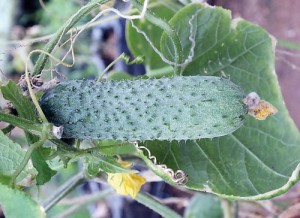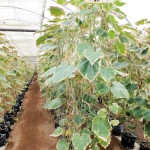NSF initiative helps sustain failing gherkin plantation owned by Hayleys
The National Science Foundation (NSF) is to double-up its approach in the search for new scientific and technological innovations and talents available in the country.
The organisation said that it has found that more publicity is still needed to make people aware that science and technology innovations and research are being are provided with technology, research and financial funding to translate these new innovation into viable marketable products.
Prof. W. L. Sumathipala, NSF Chairman told the Business Times that they have so many programmes and under one of these programmes what they do is help new innovations, new research and to popularize and disseminate the new knowledge and new technology so that they could be transformed into practical products that could be marketable.
He said that the technology development unit of the NSF encourages people who are having new ideas, innovations and research and they try to help them with a two-pronged assistance – technology assistance and financial assistance. The financial help comes from the government through the Treasury, Prof Sumathipala said.
He said that a fast developing country like Sri Lanka should keep pace with other such developing countries in picking up new ideas, innovations

Gamini Prathapasinghe
and research to translate them into viable commercial products. He said that though they are progressive in this development process, they find that they are lagging behind a little bit and now is preparing to accelerate these awareness programmes through different modes of publicity that could enable the people to pick up the message quickly. The Business Times which has been regularly reporting such innovative business, research and technological projects and the extent of obstacles these innovators face, has begun to give publicity to the NSF assistance programmes, the first of which appeared in the BT pages of 30 November issue captioned ‘Sri Lankan entrepreneur develops adjustable coconut plucking pole’.
The next in this series is how the NSF was able to save gherkin plantations from near collapse. As indicated earlier, this assistance programme was started in 2005 and when applications were called for, Sunfrost (Pvt) Ltd, the agricultural arm of the Hayleys group applied for assistance to control the melon fly attack on their gherkin plantation. Sunfrost successfully eradicated the melon fly menace with the assistance of the NSF.
To find out how the assistance of the NSF enabled the full recovery of the gherkin industry, the NSF took the BT team, along with two NSF scientific officers to Nelumdeniya, Alawwa, to the largest gherkin plantation of Sunfrost, recently.
The team was welcomed by Gamini Prathapasinghe, General Manager (Supply Chain) Sunfrost who narrated the near collapse of the gherkin  plantation in 2005 due to this melon fly attack. He told the BT that their application for assistance was accepted and NSF granted Rs. 1 million plus technical assistance. Mr. Prathapasinghe said that gherkins were grown in open fields and then the insect – melon fly attacked their plantation. They used insecticides to no avail. Then with the NSF assistance after some laboratory research, they moved the plantation into green houses. They started with one green house and the company now has nine greenhouses at the Alawwa plantation. He said that in Watagoda in the Nuwara Elia area they have a plantation of 15 greenhouses. One of the NSF Scientific Officers said that the gherkin project was one of the NSF’s first projects and it was a grand success.
plantation in 2005 due to this melon fly attack. He told the BT that their application for assistance was accepted and NSF granted Rs. 1 million plus technical assistance. Mr. Prathapasinghe said that gherkins were grown in open fields and then the insect – melon fly attacked their plantation. They used insecticides to no avail. Then with the NSF assistance after some laboratory research, they moved the plantation into green houses. They started with one green house and the company now has nine greenhouses at the Alawwa plantation. He said that in Watagoda in the Nuwara Elia area they have a plantation of 15 greenhouses. One of the NSF Scientific Officers said that the gherkin project was one of the NSF’s first projects and it was a grand success.
Mr. Prathapasinghe said that some rice farmers also grow gherkins in their paddy fields during the off season when they do not cultivate paddy. There are about 1000 farmers and sometimes that number increases to more than 3,000, he said. The harvest is purchased by the company which provides necessary fertilizer and other advise to the farmers.
He said that these farmers do not have greenhouses, but they cultivate in the open, using pesticides He said “the entire produce of gherkins is exported with around 15,000 metric tonnes exported per year to countries like Japan, Africa, South Korea, New Zealand and Australia and also in Europe.”
He said that they have been in the cultivation business for the last 25 years.
While 90 per cent of this cultivation is gherkins, the balance 10 per cent constitutes of fruits like papaya and pineapples. He said that the entire credit of sustaining the gherkin cultivation goes to the NSF. All the gherkin cultivations are now in green houses. They have several other sites too where gherkins are cultivated.


